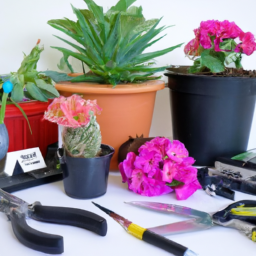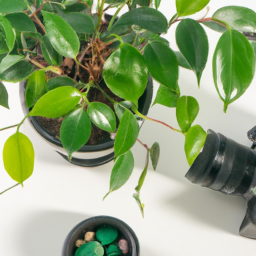
Choosing the Right Indoor Plants for Your Space
Understanding Your Indoor Environment
Before you start selecting indoor plants for your space, it’s important to understand the environmental conditions of your home or office. Different plants have different requirements for light, temperature, humidity, and air circulation. By assessing your indoor environment, you can choose plants that will thrive and create the perfect indoor plant environment.
Start by evaluating the amount of natural light your space receives. Is it bright and sunny, or does it have limited exposure to sunlight? This will help you determine which plants are suitable for your space. Additionally, consider the temperature and humidity levels. Some plants prefer warmer temperatures, while others thrive in cooler conditions. Similarly, certain plants require higher humidity levels, while others can tolerate drier air.
Lastly, assess the air circulation in your space. Good air circulation helps prevent the buildup of stagnant air and promotes healthy plant growth. If your space lacks proper ventilation, you may need to consider investing in fans or opening windows periodically to ensure adequate airflow.
Matching Plants to Your Indoor Environment
Once you have a clear understanding of your indoor environment, you can begin selecting plants that are well-suited to thrive in those conditions. Here are some popular indoor plants and their ideal environmental requirements:
Low Light Plants
If your space has limited exposure to natural light, there are still plenty of beautiful plants that can thrive in low light conditions. Some popular choices include:
- Snake Plant (Sansevieria): Snake plants are known for their resilience and ability to tolerate low light. They can also survive with infrequent watering, making them perfect for busy individuals.
- ZZ Plant (Zamioculcas zamiifolia): ZZ plants are extremely low maintenance and can tolerate low light conditions. They have attractive glossy leaves that add a touch of green to any space.
- Peace Lily (Spathiphyllum): Peace lilies are not only beautiful but also excellent air purifiers. They can thrive in low light environments and prefer slightly higher humidity levels.
Bright Light Plants
If your space receives ample natural light, consider these vibrant plants that thrive in bright light:
- Fiddle Leaf Fig (Ficus lyrata): Fiddle leaf figs are popular for their large, lush leaves. They require bright, indirect light, so placing them near a sunny window is ideal.
- Rubber Plant (Ficus elastica): Rubber plants are known for their glossy, burgundy leaves. They can tolerate bright light but should be protected from direct sunlight to prevent leaf burn.
- Spider Plant (Chlorophytum comosum): Spider plants are versatile and can adapt to a range of light conditions. They thrive in bright, indirect light but can also tolerate lower light levels.
Temperature and Humidity-Sensitive Plants
Some plants have specific temperature and humidity requirements. If your space has consistent temperature and humidity levels, consider these plants:
- Orchids: Orchids are elegant and delicate plants that require specific temperature and humidity conditions to thrive. They prefer temperatures between 60-80°F (15-27°C) and higher humidity levels.
- Boston Fern (Nephrolepis exaltata): Boston ferns are lush and feathery plants that thrive in high humidity environments. They prefer temperatures between 60-75°F (15-24°C) and indirect light.
- Aloe Vera: Aloe vera plants are known for their medicinal properties and prefer warmer temperatures between 70-80°F (21-27°C). They can tolerate lower humidity levels and are easy to care for.
Caring for Your Indoor Plants
Now that you have selected the right indoor plants for your space, it’s essential to provide them with proper care to ensure their health and longevity. Here are some general tips for caring for indoor plants:
Watering
Proper watering is crucial for the well-being of your indoor plants. Each plant has different water requirements, so it’s essential to research and understand the specific needs of your chosen plants. As a general rule, it’s better to underwater than overwater, as overwatering can lead to root rot and other issues. Check the moisture level of the soil regularly and water when it feels dry to the touch.
Lighting
Light is essential for photosynthesis, the process by which plants convert light into energy. Place your plants in areas that provide the appropriate amount of light for their specific needs. Monitor the intensity and duration of light exposure, as too much or too little light can negatively impact plant growth. Consider rotating your plants occasionally to ensure all sides receive equal light exposure.
Fertilizing
Fertilizing your indoor plants helps provide essential nutrients that may be lacking in the soil. Choose a balanced, water-soluble fertilizer and follow the instructions for application. Be cautious not to over-fertilize, as this can lead to nutrient burn and damage the plants. Fertilize your plants during their active growing season, usually spring and summer, and reduce or stop fertilization during the dormant period.
Pruning and Maintenance
Regular pruning helps promote healthy growth and keeps your plants looking tidy. Remove any dead or yellowing leaves, as they can attract pests and diseases. Additionally, trim back leggy or overgrown branches to maintain a compact and attractive shape. Regularly inspect your plants for signs of pests or diseases and take appropriate measures to address any issues promptly.
By following these steps and providing the right care, you can create the perfect indoor plant environment that not only enhances the aesthetic appeal of your space but also contributes to a healthier and more enjoyable indoor atmosphere.
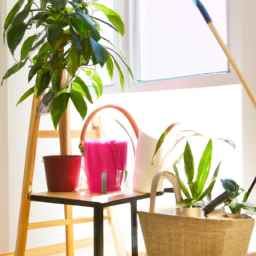
Essential Elements for Creating an Ideal Indoor Plant Environment
Introduction
Creating an ideal indoor plant environment is crucial for the health and growth of your plants. While indoor plants can thrive in a variety of conditions, providing them with the essential elements they need will ensure their longevity and vibrancy. In this guide, we will explore the key components necessary for setting up the perfect indoor plant environment. From lighting and temperature to humidity and air circulation, we will delve into each element and provide you with step-by-step instructions on how to optimize them for your indoor plants.
Lighting
Lighting is one of the most critical factors in indoor plant care. Plants need light for photosynthesis, the process by which they convert light energy into chemical energy to fuel their growth. When setting up your indoor plant environment, consider the following:
Natural Light
Position your plants near windows that receive bright, indirect sunlight. Avoid placing them in direct sunlight, as it can scorch the leaves. South-facing windows generally provide the brightest light, while east and west-facing windows offer moderate light. North-facing windows may not provide sufficient light for some plants.
Artificial Light
Supplement natural light with artificial light sources, especially if your space lacks adequate sunlight. LED grow lights are an excellent option as they emit the full spectrum of light necessary for plant growth. Position the lights 6-12 inches above the plants and keep them on for 12-16 hours a day.
Light Duration
Ensure your plants receive the right amount of light duration. Most indoor plants thrive with 12-16 hours of light per day. Use a timer to automate the light cycle and maintain consistency.
Temperature
Temperature plays a crucial role in the overall health and growth of indoor plants. Different plants have varying temperature requirements, but a general range of 65-75°F (18-24°C) is suitable for most indoor plants. Here’s how you can optimize temperature in your indoor plant environment:
Avoid Temperature Extremes
Keep your plants away from drafty windows, doors, and heating or cooling vents. Sudden temperature fluctuations can stress the plants and hinder their growth. Maintain a stable temperature by avoiding extreme hot or cold spots in your home.
Consider Seasonal Changes
Adjust the temperature in your indoor plant environment based on seasonal changes. Some plants may benefit from a cooler period during winter, while others may require additional warmth. Research the specific temperature requirements of your plants and make necessary adjustments accordingly.
Monitor Temperature Regularly
Invest in a thermometer to monitor the temperature in your indoor plant environment. This will help you identify any drastic changes and allow you to take appropriate measures to maintain optimal conditions for your plants.
Humidity
Indoor environments often have lower humidity levels than what many plants naturally thrive in. Creating the right humidity levels for your indoor plants is essential for their well-being. Follow these steps to optimize humidity in your indoor plant environment:
Misting
Mist your plants regularly with a spray bottle filled with room temperature water. This will help increase humidity levels around the plants. Focus on misting the leaves rather than the soil.
Pebble Trays
Place a tray filled with water and pebbles beneath your plants. As the water evaporates, it will create a humid microclimate around the plants. Ensure the water level in the tray is below the top of the pebbles to prevent waterlogging the plant’s roots.
Humidifiers
Consider using a humidifier to maintain consistent humidity levels in your indoor plant environment. Choose a humidifier that suits the size of your space and adjust it according to your plants’ requirements.
Air Circulation
Proper air circulation is vital for preventing stagnant air, which can lead to mold, pests, and poor plant health. Here’s how you can ensure adequate air circulation in your indoor plant environment:
Use Fans
Place fans strategically to promote air movement around your plants. Oscillating fans are particularly effective in maintaining consistent airflow. Avoid placing fans too close to delicate plants to prevent excessive drying.
Open Windows and Doors
When weather permits, open windows and doors to allow fresh air to circulate in your indoor plant environment. This will help remove stale air and provide your plants with a breath of fresh air.
Rotate Plants
Regularly rotate your plants to ensure all sides receive adequate airflow. This will prevent uneven growth and help maintain overall plant health.
Conclusion
Setting up the perfect indoor plant environment requires careful consideration of lighting, temperature, humidity, and air circulation. By providing your plants with the essential elements they need, you can create an ideal environment for their growth and well-being. Remember to monitor and adjust these factors regularly, as different plants may have specific requirements. With the right conditions in place, your indoor plants will thrive and bring beauty and vitality to your home.
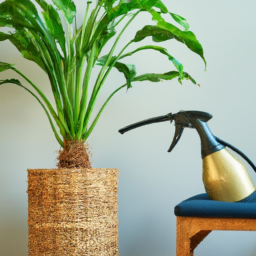
Proper Lighting Techniques for Indoor Plants
Introduction
Indoor plants bring life and vibrancy to any space, but providing them with the right amount and quality of light is crucial for their growth and overall health. Proper lighting techniques ensure that your indoor plants receive the necessary energy for photosynthesis, which is essential for their survival. In this guide, we will delve into the different aspects of lighting for indoor plants and provide you with step-by-step instructions to set up the perfect indoor plant environment.
The Importance of Light for Indoor Plants
Light is one of the most critical factors affecting the growth and development of indoor plants. It serves as the energy source for photosynthesis, the process by which plants convert light into chemical energy. Without sufficient light, plants cannot produce the necessary sugars and nutrients to support their growth. Insufficient light can lead to weak and leggy plants, with pale leaves and stunted growth.
1. Assessing Light Requirements
Before setting up your indoor plant environment, it is crucial to understand the light requirements of your specific plant species. Different plants have varying needs when it comes to light intensity, duration, and quality. Some plants thrive in bright, direct sunlight, while others prefer indirect or low light conditions. Research the specific light requirements of your plants to ensure they receive the optimal conditions for growth.
2. Understanding Light Intensity
Light intensity refers to the brightness or strength of the light reaching your plants. It is measured in foot-candles or lux. Different plants have different light intensity requirements. High-light plants typically need 2,000 to 3,000 foot-candles, while medium-light plants thrive in 1,000 to 2,000 foot-candles. Low-light plants can survive with as little as 50 to 250 foot-candles.
3. Evaluating Natural Light Sources
Natural light is the best source of illumination for indoor plants. Start by evaluating the natural light sources in your home, such as windows and skylights. South-facing windows generally receive the most intense light, while north-facing windows receive the least. East and west-facing windows provide moderate light levels. Place your plants accordingly, ensuring they receive the appropriate amount of light based on their specific requirements.
4. Supplementing with Artificial Lighting
In cases where natural light is insufficient or unavailable, artificial lighting can be used to supplement or replace natural light. There are various types of artificial lighting options available, including fluorescent, LED, and incandescent lights. LED lights are highly recommended for indoor plants due to their energy efficiency and ability to provide the full spectrum of light required for photosynthesis. When selecting artificial lights, consider the light intensity, color temperature, and duration to mimic natural lighting conditions.
Conclusion
Proper lighting techniques are vital for creating the perfect indoor plant environment. Understanding the light requirements of your plants, evaluating natural light sources, and supplementing with artificial lighting when necessary will ensure optimal growth and health for your indoor plants. Remember to regularly assess and adjust the lighting conditions as your plants grow and change. With the right lighting, your indoor plants will thrive and bring beauty and freshness to your living space.
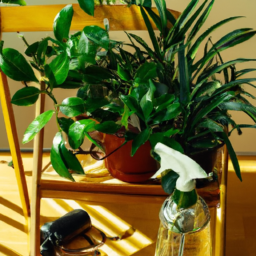
Maintaining the Ideal Temperature and Humidity for Indoor Plants
Introduction
Indoor plants are not only a beautiful addition to any space but also provide numerous health benefits, including improved air quality and reduced stress levels. However, to ensure their optimal growth and longevity, it is crucial to create and maintain the perfect environment for these green companions. One of the key factors in achieving this is maintaining the ideal temperature and humidity levels. In this guide, we will explore the importance of temperature and humidity for indoor plants and provide you with a step-by-step approach to setting up the perfect indoor plant environment.
The Role of Temperature
Temperature plays a vital role in the growth and development of indoor plants. Different plant species have specific temperature requirements, and understanding these needs will help you provide the optimal conditions for their well-being. Here are some key considerations when it comes to temperature:
1. Determine the Ideal Temperature Range
Each plant species has an ideal temperature range for optimal growth. Some plants thrive in cooler temperatures, while others prefer warmer conditions. Research the specific temperature requirements of your indoor plants to ensure they are within their preferred range. Generally, most indoor plants thrive in temperatures between 65°F (18°C) and 75°F (24°C) during the day and slightly cooler temperatures at night.
2. Consider Seasonal Temperature Variations
Just as outdoor plants experience seasonal temperature changes, indoor plants can also benefit from slight variations in temperature throughout the year. Mimicking natural temperature fluctuations can stimulate growth and encourage blooming. However, avoid extreme temperature fluctuations, as they can stress the plants and hinder their overall health.
3. Positioning Plants for Temperature Optimization
To maintain the ideal temperature for your indoor plants, consider their positioning within your space. Keep them away from drafts, such as windows and doors, as these can expose them to temperature extremes. Additionally, avoid placing plants near heat sources like radiators or air conditioning vents, as these can create localized temperature imbalances.
The Significance of Humidity
Humidity levels are equally important for indoor plants, as they directly affect their ability to absorb water and nutrients. Here’s how you can ensure optimal humidity levels for your green companions:
1. Determine the Ideal Humidity Range
Different plants have varying humidity requirements. While some thrive in high humidity environments, others prefer drier conditions. Research the specific humidity needs of your indoor plants to provide them with the ideal range. Generally, most indoor plants thrive in humidity levels between 40% and 60%.
2. Increase Humidity through Natural Methods
Increasing humidity levels in your indoor space can be achieved through various natural methods. Grouping plants together creates a microclimate that retains moisture, thus raising humidity levels. Placing a tray filled with water near your plants or using a humidifier can also help maintain adequate humidity. Additionally, misting your plants with water regularly can provide a temporary boost in humidity.
3. Decrease Humidity through Ventilation
If your indoor space has excessive humidity, it is important to decrease it to prevent issues such as mold or fungal growth. Proper ventilation, including opening windows or using fans, can help circulate air and reduce humidity levels. However, ensure that you strike a balance and do not create a dry environment that can harm your plants.
Conclusion
Maintaining the ideal temperature and humidity levels for your indoor plants is essential for their overall health and well-being. By understanding the specific temperature and humidity requirements of your plant species, positioning them appropriately, and employing natural methods to adjust humidity levels, you can create the perfect environment for your green companions. Remember to regularly monitor and adjust these factors as necessary, ensuring your indoor plants thrive and bring beauty and tranquility to your space.
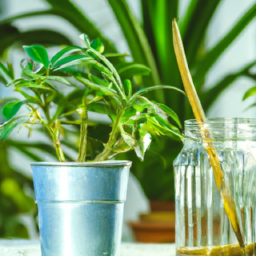
Tips for Proper Watering and Fertilizing of Indoor Plants
Indoor plants require proper watering and fertilizing to thrive and maintain their health. In this guide, we will provide you with essential tips to set up the perfect indoor plant environment.
1. Understanding the Watering Needs of Indoor Plants
Watering indoor plants may seem simple, but it requires attention to detail. Here are some key factors to consider:
1.1. Observe the Plant’s Watering Requirements: Different indoor plants have varying watering needs. Some plants prefer moist soil, while others prefer drier conditions. Research the specific watering requirements of your plants to ensure you provide the right amount of water.
1.2. Test the Soil Moisture: Before watering, check the moisture level of the soil. Insert your finger about an inch deep into the soil. If it feels dry, it’s time to water the plant. If it’s still moist, wait a little longer before watering.
1.3. Watering Frequency: The frequency of watering depends on various factors such as plant type, pot size, humidity, and temperature. As a general rule, most indoor plants need watering once or twice a week. However, always adjust the frequency based on the specific needs of your plants.
2. Proper Techniques for Watering Indoor Plants
Now that you understand the watering needs of your indoor plants, let’s explore some effective techniques:
2.1. Watering from the Base: To avoid overwatering and prevent waterlogging, it is best to water your indoor plants from the base. Place the pot in a tray or saucer filled with water and allow the plant to absorb the water through the drainage holes. Once the topsoil becomes moist, remove the pot from the tray.
2.2. Use the Right Amount of Water: It’s crucial to provide enough water without drowning the plant. Ensure that the water reaches the root zone by watering until you see it coming out of the drainage holes. Discard any excess water to prevent water accumulation.
2.3. Avoid Watering the Leaves: Watering the leaves directly can lead to fungal diseases. Instead, focus on watering the soil and root area. Use a watering can or a narrow spout to direct the water precisely where it’s needed.
3. Fertilizing Indoor Plants for Optimal Growth
Fertilizing indoor plants is essential to provide them with the necessary nutrients for healthy growth. Consider the following tips:
3.1. Choose the Right Fertilizer: There are various types of fertilizers available, including liquid, granular, and slow-release options. Select a fertilizer specifically formulated for indoor plants and follow the instructions on the package for proper usage.
3.2. Determine the Fertilizing Schedule: Indoor plants generally require fertilization every 2-4 weeks during the growing season (spring and summer). However, reduce the frequency to once every 6-8 weeks during the dormant period (fall and winter). Adjust the schedule based on the specific needs of your plants.
3.3. Apply Fertilizer Correctly: Before applying fertilizer, ensure the soil is moist. Dilute liquid fertilizers according to the instructions and apply them directly to the soil. For granular or slow-release fertilizers, sprinkle them evenly on the soil surface, avoiding direct contact with the plant’s stem or leaves.
By following these watering and fertilizing tips, you can create the perfect indoor plant environment and promote healthy growth. Remember to monitor your plants closely, observe any signs of overwatering or nutrient deficiencies, and make adjustments accordingly. With proper care, your indoor plants will thrive and enhance the beauty of your living space.
Frequently Asked Questions (FAQ)
1. What are the key factors to consider when setting up the perfect indoor plant environment?
Some key factors to consider include lighting, temperature, humidity, air circulation, and proper watering techniques.
2. What type of lighting is best for indoor plants?
Most indoor plants thrive with bright, indirect light. Consider placing them near a window or using artificial grow lights.
3. How can I ensure the right temperature for my indoor plants?
Most indoor plants prefer temperatures between 60-75°F (15-24°C). Avoid placing them near drafts or extreme temperature changes.
4. What is the ideal humidity level for indoor plants?
The ideal humidity level for most indoor plants is around 40-60%. You can increase humidity by using a humidifier or grouping plants together.
5. How important is air circulation for indoor plants?
Air circulation is crucial for preventing stagnant air and promoting healthy growth. Consider using fans or opening windows periodically.
6. How often should I water my indoor plants?
The watering frequency depends on the type of plant and its specific needs. It’s best to check the soil moisture before watering and avoid overwatering.
7. What type of soil is suitable for indoor plants?
Well-draining potting soil is generally recommended for indoor plants. It should retain enough moisture while allowing excess water to drain.
8. Do indoor plants require fertilizers?
Yes, indoor plants benefit from regular fertilization during the growing season. Choose a balanced, water-soluble fertilizer and follow the instructions.
9. How can I prevent pests from infesting my indoor plants?
Regularly inspect your plants for signs of pests and take immediate action if detected. Keep your plants clean, avoid overwatering, and consider using natural pest control methods.
10. What are some common signs of plant stress or problems?
Common signs of plant stress include yellowing leaves, wilting, leaf spots, stunted growth, and pest infestations. Pay attention to any changes and address them promptly.
Dr. Olivia Green is a botanist with over two decades of experience in indoor plant cultivation. She holds a Ph.D. in Plant Biology and has dedicated her career to researching plant behavior in controlled environments. Dr. Green is passionate about helping plant enthusiasts master the art of indoor gardening through her extensive knowledge and practical insights.


